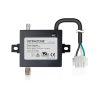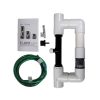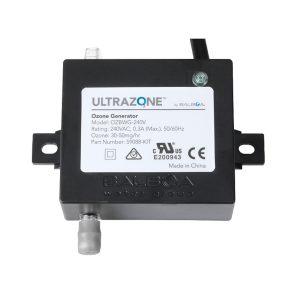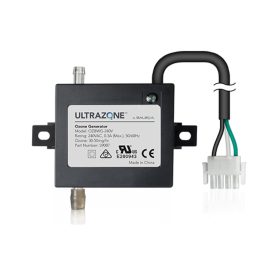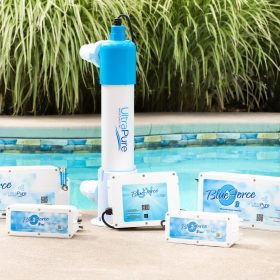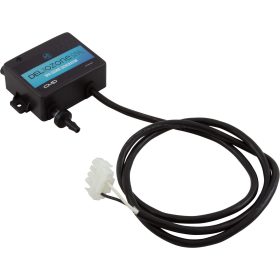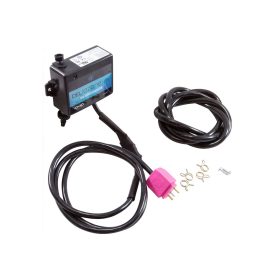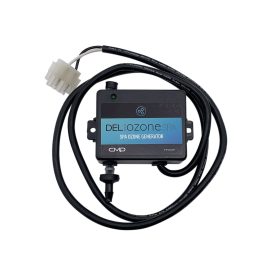Balboa Ozonator 59088-KIT
This Ozonator is manufactured by Balboa. With over three decades of innovative designs, Balboa Water Group is proud to offer a diverse portfolio of world-class products for your whirlpool bath or hot tub. One of Balboa’s key differentiators over the years has been our ability to drive invention that enables our customers’ long-term success. Market changes have never occurred at a faster pace than we are seeing today. At the heart of each of these needs – usability, flexibility, and manufacturability is our core competence of providing custom solutions around our product lines. Balboa is focused on driving the opportunities created by these needs, and creating value for our customers and their end users.
- Ultrazone, 230V, 4 Pin Amp Plug
Additional Information
| Cord Type | 4 Pin Amp |
| Type | Standard |
| Voltage | 230 |
Alternate Part Numbers
- 54451
- BAL59088
- BB59088
- 54449
What is an Ozonator
An ozonator for a hot tub is a device that generates and injects ozone gas into the water to disinfect and sanitize the hot tub. Ozone, a highly reactive form of oxygen (O3), is a powerful oxidizer and an effective sanitizer. When ozone is introduced into the hot tub water, it helps break down and eliminate various contaminants, including bacteria, viruses, algae, and other organic matter.
Ozonators for hot tubs typically consist of a corona discharge unit that creates ozone gas from oxygen molecules. The ozone gas is then injected into the water through a dedicated ozone jet or a mixing chamber in the hot tub plumbing. As the ozone gas reacts with the contaminants, it oxidizes and destroys them, leaving the water clean, clear, and safe for use.
Ozonators are popular in hot tubs because they provide an additional layer of water
treatment, reducing the reliance on traditional chemical sanitizers like chlorine or bromine. They are environmentally friendly, as ozone breaks down into oxygen without leaving any harmful by-products. Additionally, using an ozonator can help reduce the overall amount of chemicals needed to maintain the hot tub water, creating a more enjoyable and natural soaking experience.
How does an Ozonator work?
An ozonator works by generating ozone gas (O3) and injecting it into the hot tub water to disinfect and sanitize it. The process involves the following steps:
- Ozone Generation: The ozonator contains a corona discharge unit or UV light chamber, depending on the type of ozonator. In a corona discharge unit, oxygen molecules (O2) are exposed to an electrical discharge, breaking them down into individual oxygen atoms. Some of these atoms then combine with other oxygen molecules, forming ozone (O3). In a UV light chamber, ultraviolet light is used to break down oxygen molecules and form ozone.
- Ozone Injection: Once the ozone is generated, it is injected into the hot tub water. This can be done through a dedicated ozone jet or a mixing chamber in the hot tub plumbing. The ozone gas mixes with the water, creating an effective oxidizing agent.
- Oxidation and Sanitization: Ozone is a powerful oxidizer, meaning it readily reacts with and breaks down contaminants in the water. When ozone comes into contact with bacteria, viruses, algae, oils, and other organic matter, it reacts with them and destroys their cell walls, effectively sanitizing the water.
- Decomposition: After the oxidation process, the ozone reverts back to regular oxygen (O2). It breaks down into oxygen molecules, leaving no harmful by-products in the water. This natural decomposition process makes ozonators an environmentally friendly method of water treatment.
Ozonators work alongside other hot tub sanitizing methods, such as chlorine or bromine, to provide an additional layer of water treatment. By reducing the reliance on traditional chemicals, ozonators can help maintain cleaner and clearer hot tub water, providing a more enjoyable and refreshing soaking experience.
What are the benefits of Ozonators?
Ozonators offer several benefits for hot tub water treatment, making them a popular choice among hot tub owners:
- Efficient Sanitization: Ozonators are highly effective at sanitizing hot tub water by eliminating bacteria, viruses, algae, and other contaminants. Ozone is a powerful oxidizer, capable of destroying harmful microorganisms more quickly than traditional sanitizers like chlorine or bromine.
- Reduced Chemical Usage: With an ozonator, hot tub owners can significantly reduce the reliance on traditional sanitizing chemicals. Ozone helps to keep the water clean and clear, reducing the need for excessive chlorine or bromine usage. This leads to a gentler and more pleasant soaking experience.
- Odor Reduction: Ozone helps eliminate unpleasant odors in the hot tub water caused by organic matter, such as sweat, body oils, and cosmetics. As ozone oxidizes these substances, it breaks them down, reducing foul smells and creating a fresher environment in the hot tub.
- Improved Water Clarity: By breaking down organic particles and contaminants, ozonators help maintain water clarity. This leads to crystal-clear water, enhancing the overall appearance of the hot tub and creating a more inviting environment.
- Environmentally Friendly: Ozone is a natural gas and does not produce harmful by-products. Unlike some chemical sanitizers, ozonators do not leave behind residues or harmful substances, making them an eco-friendly water treatment option.
- Extended Chemical Lifespan: Using an ozonator can prolong the lifespan of traditional hot tub sanitizers like chlorine or bromine. Since ozone assists in sanitization, chemical levels can be maintained at lower concentrations, reducing chemical consumption and saving money in the long run.
- Less Skin and Eye Irritation: With reduced chemical usage and cleaner water, hot tub users may experience less skin and eye irritation. Ozone-treated water is milder on the skin and less likely to cause dryness or irritation.
- Ease of Use: Once installed, ozonators operate automatically, requiring little maintenance. They are designed to work in conjunction with the hot tub's circulation system, ensuring a continuous and efficient water treatment process.
It's important to note that while ozonators offer numerous benefits, they are not a standalone solution for hot tub water treatment. Ozonators complement traditional sanitizers and are most effective when used in conjunction with them. Regular water testing and maintenance are still necessary.
Ozonator, Balboa, ULTRAZO3NE, Kit, 230V, w/4 Pin Amp Plug | $85.44 Max: 14 Min: 1 Step: 1 Add to cart | |
Ozonator, Balboa, ULTRAZO3NE, Kit, 115V, w/4 Pin Amp Plug | $85.44 Max: 14 Min: 1 Step: 1 Add to cart | |
Ozonator Kit, HydroQuip WaterPro Max O3zone, 115/230V, 150 mg up to 1500 Gallons | $93.63 Max: 1 Min: 1 Step: 1 Add to cart | |
Ozonator, JED, Corona Discharge, 230V, w/4 Pin Amp Cord | $138.25 Max: 10 Min: 1 Step: 1 Add to cart | |
Ozonator, Ultra Pure, BFO3, 230V, 60Hz, 4 Prong Amp | $143.94 Max: 10 Min: 1 Step: 1 Add to cart | |
Ozonator, APG, 230V, w/Mini J&J Plug | $165.21 Max: 13 Min: 1 Step: 1 Add to cart | |
Ozonator, CMP/Del Ozone, 115/230V, Amp Plug, 1/8” × 1/4” Check Valve | $177.25 Max: 91 Min: 1 Step: 1 Add to cart | |
Ozonator, CMP/Del Ozone, UO3-JJ, 1/8 x 1/4 Check valve, Comes with 5' of tubing, hardware and J&J Cord | $232.30 Max: 17 Min: 1 Step: 1 Add to cart | |
Ozonator, CMP/Del Ozone, UO3-AMP, 115/230V, 1/8 x 1/4 Check valve, Comes with 5' of tubing and hardware | $239.66 Max: 43 Min: 1 Step: 1 Add to cart | |
Control System, Dreamaker Spas, (Balboa) RS81 Heat Recovery, M7, 115V, w/14' GFCI Cord | $389.76 Max: 11 Min: 1 Step: 1 Add to cart |
How do I replace an Ozonator?
Replacing an ozonator in a hot tub can be a straightforward process. Here's a general guide to help you with the replacement:
- Purchase a Compatible Replacement: Before beginning the replacement process, ensure you have a new ozonator that is compatible with your hot tub model and its existing plumbing and electrical connections. Refer to the hot tub's manual or consult with a hot tub supplier like parts4tubs.com to find the right replacement.
- Turn off Power: Before working on any electrical components, make sure to turn off the power to the hot tub. This step is crucial for safety and to avoid electrical shocks.
- Locate the Old Ozonator: Find the existing ozonator in your hot tub. It is usually installed near the equipment area, often mounted on a wall or on the hot tub shell.
- Disconnect the Old Ozonator: Carefully disconnect the electrical connections to the old ozonator. This may include disconnecting wires or plugs from the ozonator and the control panel.
- Remove the Old Ozonator: Once the electrical connections are disconnected, you can proceed to remove the old ozonator. This may involve unscrewing it from its mounting bracket or detaching it from the hot tub shell.
- Install the New Ozonator: Position the new ozonator in place, aligning it with the mounting bracket or securing points. Make sure to follow the manufacturer's instructions for proper positioning and orientation.
- Reconnect Electrical Connections: Carefully reconnect the electrical connections to the new ozonator, matching the appropriate terminals. Double-check the connections to ensure they are secure and properly insulated.
- Test the New Ozonator: After installation and reconnection, turn the power back on to the hot tub and test the new ozonator. Ensure that it is functioning correctly and producing ozone.
- Check for Leaks: Run the hot tub for a while and check for any water leaks around the new ozonator. If you notice any leaks, turn off the power and recheck the connections for proper sealing.
- Adjust Settings (if necessary): Some ozonators may have adjustable settings for ozone output. If needed, adjust the settings according to the manufacturer's recommendations or your hot tub's specific requirements.
- Regular Maintenance: Once the replacement is complete, perform regular maintenance and check the ozonator periodically to ensure it continues to function effectively.
Is an ozonator dangerous?
An ozonator itself is not inherently dangerous when used properly. However, as with any electrical component, there are safety considerations that need to be taken into account.
The main safety concern with ozonators is related to the production of ozone gas. Ozone is a powerful oxidant and can be harmful if inhaled in large quantities. Therefore, it is essential to ensure that the ozonator is installed and operated according to the manufacturer's instructions and safety guidelines.
Here are some important safety considerations for using an ozonator in a hot tub:
- Proper Ventilation: Ozone gas should never be directly inhaled. Ensure that the hot tub area is well-ventilated to prevent ozone buildup. Adequate ventilation allows excess ozone to dissipate into the open air, reducing the risk of inhalation.
- Ozone Output: The ozonator should be set to the appropriate ozone output level recommended by the manufacturer for the size of the hot tub. Using too much ozone can be harmful, while too little may not effectively sanitize the water.
- Follow Manufacturer's Guidelines: Always follow the manufacturer's guidelines for installation, operation, and maintenance of the ozonator. This includes proper electrical connections, positioning, and replacement intervals.
- Monitor Ozone Levels: Some ozonators come with built-in ozone monitors or indicators. Regularly check the ozone levels to ensure they are within the safe range.
- Routine Inspection: Periodically inspect the ozonator and its components for any signs of wear, damage, or malfunction. If any issues are detected, address them promptly or seek professional assistance.
| Brand | Balboa |
|---|
Related products
Hydro-Quip Heaters
Spa Accessories
Gecko Spa Pack Controls
Hydro-Quip Heaters
Hydro-Quip Outdoor Series 11kW 230V Flow Thru Heater 26-0054AF-M7-KS
Master Spa Circuit Boards
Balboa Topside Controls (Overlays)

